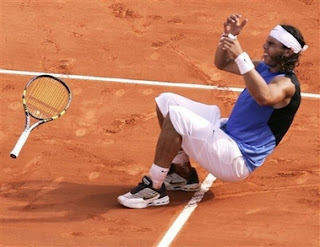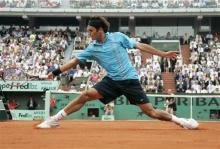[I was advised not to post this on the blog until after it had been published.
Subsequent mails and phone calls went unheeded. Now I'm informed - in passing, mind you - that it has indeed been published, I know not where.
Even if it hasn't, here goes. I mean, how long can I hold in 2200 words?!]
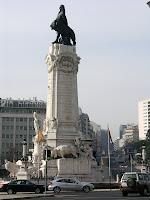
One o’ clock on a Saturday afternoon and the streets of Lisbon are quiet. A few cars and one large yellow bus whoosh down the Avenida de Liberdade towards the Rossio. From his vantage point 40 feet above me, left hand resting theatrically on a lion’s mane, Sebastiao de Melo, Marquis de Pombal, once Prime Minister of the Kingdom of Portugal, watches them on their way. What a name. Pombal. Pom-bal. Pom-ba-line. I like this town already.
Strolling down the Liberdade, it’s hard to believe that most of this city was wiped out in the 18th century. On 1st November 1755, All Saints’ Day, an earthquake believed to have measured 9+ on the Richter Scale shook Lisboa for four minutes or more. The little that was left standing after earth and fire was soon destroyed by water. Forty minutes after the earthquake, a tsunami in three waves swept over downtown Lisbon. In the aftermath of destruction, the Marques de Pombal, came into his own.
 Given a free hand by King Joseph I, the Marques rebuilt Lisbon on pragmatic lines (and came up with one of the great quotes from an administrator. Asked what should be done after the catastrophe, he said phlegmatically, “Now? Bury the dead and feed the living”) The Lisbon disaster also spurred the first survey of seismology – the Marquis circulated a questionnaire about phenomena that might help to warn
Given a free hand by King Joseph I, the Marques rebuilt Lisbon on pragmatic lines (and came up with one of the great quotes from an administrator. Asked what should be done after the catastrophe, he said phlegmatically, “Now? Bury the dead and feed the living”) The Lisbon disaster also spurred the first survey of seismology – the Marquis circulated a questionnaire about phenomena that might help to warn 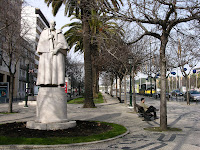 of an earthquake. The downtown area, or Baixa, now has large squares and wide avenues in a rectilinear grid. This is the area where I am headed, down the Avenida. Past palm trees, flower beds, wrought-iron railings on sleeping buildings, the mouths of cobbled alleys leading uphill, languorous hotels, statues of cardinals, contemplative old men on sun-warmed stone benches.
of an earthquake. The downtown area, or Baixa, now has large squares and wide avenues in a rectilinear grid. This is the area where I am headed, down the Avenida. Past palm trees, flower beds, wrought-iron railings on sleeping buildings, the mouths of cobbled alleys leading uphill, languorous hotels, statues of cardinals, contemplative old men on sun-warmed stone benches.
Despite the late hour, the city is just stirring to life. Friday nights in Lisbon may not end at sunrise. Saturdays don’t start till late afternoon. Which is a problem. I haven’t eaten anything since an early breakfast, my stomach thinks my throat’s been cut, but the shops are yet to open. Half a mile up the road, I find a café that’s just opening. When I grimace at Salvatore’s suggestion of a turkey sandwich, he ushers me to a chair in the sun (very welcome in the chill of January), gets me a coffee for ‘while I wait’, then an ashtray so I don’t tip my cigarillo over his freshly-swept sidewalk. Half an hour later, I stifle a gasp at the ludicrous bill – where else in Europe can one eat one’s fill for 5 Euros? Having put myself outside the coffee and a steak sandwich the size of a young carpet, I tool onwards towards the Rossio, filled with a vague sense of goodwill towards my fellow man (probably induced by Salvatore’s infectious smile).
Even the sidewalks are special in Lisbon. Where other cities might have cement or at most cobblestones, Lisbon has mosaic. Everywhere. The Romans are to blame for this (as indeed for most things in western Europe); they started it all by paving their vias with it. It’s a little slippery underfoot at times and I’m told it doesn’t wear well. Yet the art of calcada, as it is locally known, produces not just a curiosity but works of art underfoot. The sidewalks and piazzas of Lisbon seem to flow and undulate with patterns. Sadly enough, it is a dying art. Low pay, cheaper alternative materials and the arduous process seem to discourage its perpetuation. I consoled myself that the mosaics will at least last my lifetime, they’ll still be around when I return to this endearing city.
The Avenida de Liberdade ends behind the Teatro Nacionale. Strictly speaking, it ends in the side wall 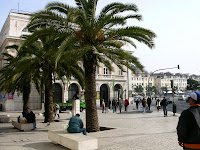 of a café that also sells little gift-packs of wine. PORT wine, of course. The name comes not from Portugal itself but from Porto at the mouth of the Douros river, whence it was shipped to England after the Treaty of Methuen in 1703. (The terms of the treaty needn’t concern us, except that it had something to do with the effects of Anglo-Gallic bickering and the banning of French wines in England.) Technically, only the right wines from Portugal can be labelled Porto or Vinho do Porto.
of a café that also sells little gift-packs of wine. PORT wine, of course. The name comes not from Portugal itself but from Porto at the mouth of the Douros river, whence it was shipped to England after the Treaty of Methuen in 1703. (The terms of the treaty needn’t concern us, except that it had something to do with the effects of Anglo-Gallic bickering and the banning of French wines in England.) Technically, only the right wines from Portugal can be labelled Porto or Vinho do Porto.
I am, of course, an oenophile of some standing, with considerable expertise in distinguishing between the two main types of wine. To wit, Wine I Like and Wine I Don’t Like. Since Port is Wine I Like, buying should have been a simple operation. Until the man behind the counter asks me what KIND of port I want – tawny, vintage or (with a faint shudder) ruby? Or would I like some Garrafeira? Even, if Senhor is a connoisseur, some Reserve? (The capital letter was evident from his reverent enunciation) I mumble something about coming back later and beat a hasty retreat.
As one rounds the corner from the Teatro Nacional 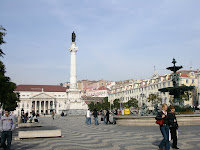 (which has a library upstairs AND a café in the front porch – how typically Lisbon!) one is in the Praca Dom Pedro IV. Over the last thousand years it has been used at various times as a cattle market, a public execution center, bullfight arena and carnival ground. Today the Praça and its cafes are the heart of Lisbon. No native, however, can direct you to it. Lisbon’s town square is universally known (nobody knows
(which has a library upstairs AND a café in the front porch – how typically Lisbon!) one is in the Praca Dom Pedro IV. Over the last thousand years it has been used at various times as a cattle market, a public execution center, bullfight arena and carnival ground. Today the Praça and its cafes are the heart of Lisbon. No native, however, can direct you to it. Lisbon’s town square is universally known (nobody knows 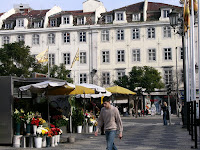 why) only as the Rossio. Surrounded by baroque buildings and arcades, overlooked by tiled houses sprawled across one of Lisbon’s seven hills, the Rossio is unique in my experience because it is paved with acres of calcada. The square seems to heave and flow with the patterns. As I stroll across the waves of mosaic, cafes and flower stalls stir into life.
why) only as the Rossio. Surrounded by baroque buildings and arcades, overlooked by tiled houses sprawled across one of Lisbon’s seven hills, the Rossio is unique in my experience because it is paved with acres of calcada. The square seems to heave and flow with the patterns. As I stroll across the waves of mosaic, cafes and flower stalls stir into life.
Across the Rossio, through an old archway and down the 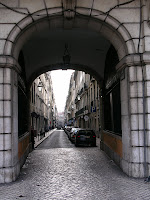 Rua dos Sapateiros, the Street of the Shoemakers. Curlicued balconies muse in the noonday sun as it creeps into this
Rua dos Sapateiros, the Street of the Shoemakers. Curlicued balconies muse in the noonday sun as it creeps into this  canyon of quiet. Turn right at the first crossroad (cross-alley?) and you face the Elevador de Santa Justa. This metal fantasy with a viewing terrace on top was built in 1902 by Raoul Mesnier de Ponsard, but its appearance has spawned the urban myth that it was designed by Gustav Eiffel. Not surprising, since Ponsard was Eiffel’s student. The Santa Justa is the only vertical elevador in Lisbon – the rest are funiculars - and has little purpose other than to provide a view of the town. But surely that’s a good enough raison d’etre?
canyon of quiet. Turn right at the first crossroad (cross-alley?) and you face the Elevador de Santa Justa. This metal fantasy with a viewing terrace on top was built in 1902 by Raoul Mesnier de Ponsard, but its appearance has spawned the urban myth that it was designed by Gustav Eiffel. Not surprising, since Ponsard was Eiffel’s student. The Santa Justa is the only vertical elevador in Lisbon – the rest are funiculars - and has little purpose other than to provide a view of the town. But surely that’s a good enough raison d’etre?
Turn left, cross the Rua do Ouro or Street of the Goldsmiths and you find yourself in the Rua Augusta, a magnificent paved promenade that leads down, across the tram-lines to the Praca de Comercio and the sea. Vasco da Gama sailed from here, and Ferdinand Magellan. After 1755 it was rebuilt on a grander scale and its several acres are now ringed by ornate Pombaline architecture. This used to be one of the symbols of Portugal’s maritime might. It does not lack for grandeur, even though the space overhead is scarred with electric wires and tramcar cables. Now, as I rest my legs on a convenient bench, a seedy man with a piebald stubble and a leprous leather jacket sidles up and tries to sell me drugs. Time to move on.
After 1755 it was rebuilt on a grander scale and its several acres are now ringed by ornate Pombaline architecture. This used to be one of the symbols of Portugal’s maritime might. It does not lack for grandeur, even though the space overhead is scarred with electric wires and tramcar cables. Now, as I rest my legs on a convenient bench, a seedy man with a piebald stubble and a leprous leather jacket sidles up and tries to sell me drugs. Time to move on.
To the opposite corner of the Praca, where a red tramcar serves as a tourist office. 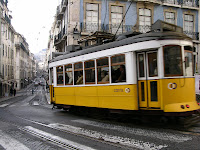 Directions, and then down the crazy cobbled street to catch a real tram, the fabled No. 28. This route goes all the way up through the winding streets of the old district, down the other side and ends in a square beside the Rossio. (I discovered that this square is about a 5 minute walk from where I boarded the tram on the other side of the Alfama!)
Directions, and then down the crazy cobbled street to catch a real tram, the fabled No. 28. This route goes all the way up through the winding streets of the old district, down the other side and ends in a square beside the Rossio. (I discovered that this square is about a 5 minute walk from where I boarded the tram on the other side of the Alfama!)
800 years ago, the Alfama was Lisbon. Its name, drawn from Al-hammam, ‘the baths’, reveals the Moorish influence (still visible in some of the architecture). As the city spread to the west, the Alfama (like Chandni Chowk in Delhi or Whitechapel in London) became  the district of the poor and the fisher-folk. Unlike the more fashionable Baixa, it survived the 1755 calamity because it was built on a hill. This heritage district is honeycombed with steep cobbled lanes, some so narrow that I flinch as the tram rattles headlong through them. On some stretches the tram runs on a single line, stopping and checking for traffic in the other direction. Alonso, the driver, never loses his smile and flirts scandalously throughout the journey with an old lady who affectionately taps him on the head with her bag. We pass bakeries, front parlours, tiny shop-fronts. The window of a second-hand book-store provides a tantalizing glimpse of a Portugues edition of Red Rackham’s Treasure, two old ladies quarrel in genteel fashion on a tiny terrace.
the district of the poor and the fisher-folk. Unlike the more fashionable Baixa, it survived the 1755 calamity because it was built on a hill. This heritage district is honeycombed with steep cobbled lanes, some so narrow that I flinch as the tram rattles headlong through them. On some stretches the tram runs on a single line, stopping and checking for traffic in the other direction. Alonso, the driver, never loses his smile and flirts scandalously throughout the journey with an old lady who affectionately taps him on the head with her bag. We pass bakeries, front parlours, tiny shop-fronts. The window of a second-hand book-store provides a tantalizing glimpse of a Portugues edition of Red Rackham’s Treasure, two old ladies quarrel in genteel fashion on a tiny terrace.
Round a corner, a huge church appears, looking down over the sprawl of tiled roofs to the sea. 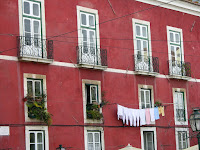 On the landward side a building’s cheery red façade is punctuated with a cheeky line of washing. This, notwithstanding the drying clothes, is the Museu de Artes Decorativas or Museum of Decorative Arts. A chance foray across the road yields an epiphany. TheAlfama is studded with little terraces or Miradouros, and on the one I have found, the Miradouro de Santa
On the landward side a building’s cheery red façade is punctuated with a cheeky line of washing. This, notwithstanding the drying clothes, is the Museu de Artes Decorativas or Museum of Decorative Arts. A chance foray across the road yields an epiphany. TheAlfama is studded with little terraces or Miradouros, and on the one I have found, the Miradouro de Santa 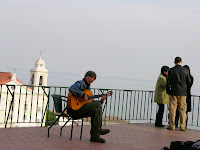 Lucia, sits an old man who could be the Spirit of Lisbon. Eyes closed, immersed in the spirit of his music, he picks at his guitar and hums almost to himself. The open
Lucia, sits an old man who could be the Spirit of Lisbon. Eyes closed, immersed in the spirit of his music, he picks at his guitar and hums almost to himself. The open 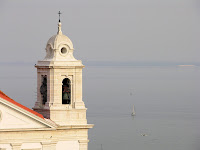 guitar-case in front of him is a technical detail, almost irrelevant, and I hesitate to throw in a coin. Lovers stand by the inevitable wrought-iron railing, holding hands as they look at the sea and a lone sailboat tacking in the afternoon light. A sonorous bell in the church tower strikes the hour, the deep notes somehow accentuating the dream-like perfection of the moment. The church, the sea and an old man’s music. Lisbon.
guitar-case in front of him is a technical detail, almost irrelevant, and I hesitate to throw in a coin. Lovers stand by the inevitable wrought-iron railing, holding hands as they look at the sea and a lone sailboat tacking in the afternoon light. A sonorous bell in the church tower strikes the hour, the deep notes somehow accentuating the dream-like perfection of the moment. The church, the sea and an old man’s music. Lisbon.
As the light lengthens and the day fades,  I bestir myself in search of the Castello. Round a corner and up another series of precipitous lanes, past a little square where a couple while away the late afternoon on a terrace, and finally the gateway to the Castle is in sight.
I bestir myself in search of the Castello. Round a corner and up another series of precipitous lanes, past a little square where a couple while away the late afternoon on a terrace, and finally the gateway to the Castle is in sight. 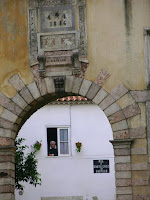
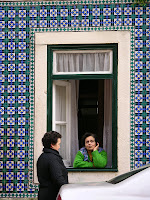 The gatekeeper, musing on the line of tourists filing past his window, is an equally interesting relic. As are the two ladies who chat through a window, framed prettily by the ceramic tiles or azulejos that adorn the facades of so many houses here.
The gatekeeper, musing on the line of tourists filing past his window, is an equally interesting relic. As are the two ladies who chat through a window, framed prettily by the ceramic tiles or azulejos that adorn the facades of so many houses here.
The Castle of St. George is a Moorish pile dedicated to an English saint in the 14th century by John I, probably influenced by his bride Philippa of Lancaster. Once the centre of Lisbon and the home of royalty, the Castelo de Sao Jorge is old – very old, the first fortifications date back to the 2nd century BC – and now it is tired. Battered by sieges, rocked by earthquakes, forsaken by monarchs (Manuel I shifted the royal residence to the Ribeira Palace on the banks of the Tagus), the Castelo has been restored since the 1940s. Now, dreaming on its hilltop, it offers perhaps the best views of Lisbon.
Evening is drawing in as I pick my way down from the Castle. My sense of direction, confronted with the random serpentine meandering, soon gives up. The lane is deserted, nobody from whom I could ask directions. (Even if they understood English, which is not very likely considering my experiences through the day. Friendly, yes. Helpful, yes. Charming, yes. Intelligible, no. The vigorous hand-waving is reassuring, though. They MEAN well.)
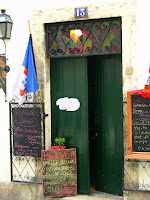 As I pause for breath, a most intriguing doorway catches my eye. I push the door open and peek in. I am initially confronted by a male posterior, which soon
As I pause for breath, a most intriguing doorway catches my eye. I push the door open and peek in. I am initially confronted by a male posterior, which soon 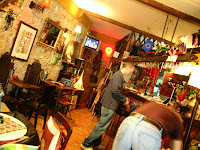 turns into a friendly Irishman who assures me that I can get some, aahh, refreshment on the premises. I find a table in the colourfully kitschy mess, a coffee appears, Eamon joins me and we light up our cigarillos. His Portuguese friend Paula, who runs the place (‘I don’t WORK here, y’know, I’m only press-ganged when Paula needs the place done up’), wanders over. Time passes. I am offered, in quick succession, something from Czechoslovakia, something from Bulgaria, something from France and several somethings from our very own Lisboa. I am unwise enough to accept. Paula’s daughter drops in and helps me print out my ticket for my flight next day. More time passes. The floor seems suddenly distant. A plum tart appears and is ingested. Eventually, in one of the increasingly rare interludes of clarity, I realise that (a) it is dark outside (b) I had better leave before the shops close, or risk the wrath of a Better Half Deprived of Souvenirs and (c) in any case it would be wise to leave while I can still walk.
turns into a friendly Irishman who assures me that I can get some, aahh, refreshment on the premises. I find a table in the colourfully kitschy mess, a coffee appears, Eamon joins me and we light up our cigarillos. His Portuguese friend Paula, who runs the place (‘I don’t WORK here, y’know, I’m only press-ganged when Paula needs the place done up’), wanders over. Time passes. I am offered, in quick succession, something from Czechoslovakia, something from Bulgaria, something from France and several somethings from our very own Lisboa. I am unwise enough to accept. Paula’s daughter drops in and helps me print out my ticket for my flight next day. More time passes. The floor seems suddenly distant. A plum tart appears and is ingested. Eventually, in one of the increasingly rare interludes of clarity, I realise that (a) it is dark outside (b) I had better leave before the shops close, or risk the wrath of a Better Half Deprived of Souvenirs and (c) in any case it would be wise to leave while I can still walk.
Paula and Eamon refuse to accept any payment. Even for the coffee, which I had ordered ‘before we were friends’. Phone numbers are exchanged, e-mail addresses traded. As I step out, the cool of the evening clears my head somewhat. The street lights are coming on in haphazard fashion as I step into a church at evensong. Despite my lack of faith, the physical experience is uplifting. I have mixed feelings, however, about the teen couple alternately genuflecting and snogging in the last pew. I wander out again, the evening meandering through more cobbled alleys, past open doors and bright cafes with the tables laid, down uneven stairs that take sudden detours. The day is ended, the night lies ahead. I head hotel-wards under the emerging stars with my hat at a rakish angle.
On the last leg through the Alfama, a name and a frame. I shall be back for more.


 or the quarters but never ever win. Once in a while fairy-tales come true. Jana Novotna beating Nathalie Tauziat in the ’98 final, 5 years after she cried on the shoulder of the Duchess of Kent. The beauty of that final was that no matter WHO won, it would have been a fairy-tale finish.
or the quarters but never ever win. Once in a while fairy-tales come true. Jana Novotna beating Nathalie Tauziat in the ’98 final, 5 years after she cried on the shoulder of the Duchess of Kent. The beauty of that final was that no matter WHO won, it would have been a fairy-tale finish. the fifth set as well, Goran wins the set and match. Who won
the fifth set as well, Goran wins the set and match. Who won 







